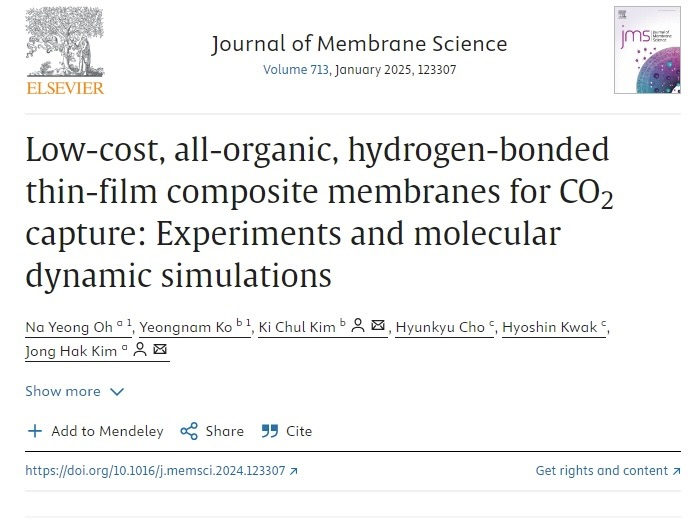Bio
SK Innovation develops low-cost membrane for carbon capture
 |
The joint research effort between SK Innovation Institute of Environmental Science and Technology, SKIET’s R&D Center and Professor Kim Jong-haek of Yonsei University has recently been published in the Journal of Membrane Science, a top journal in the field. Their paper outlines the development of an all-organic, hydrogen-bonded membrane for carbon capture. (SK Innovation) |
SK Innovation, with its subsidiary SK IE Technology and researchers from Yonsei University, has developed a next-generation technology designed to capture carbon emissions more efficiently and at a lower cost. This breakthrough could have significant implications for the biggest carbon-emitting industries, such as power plants, steel mills and cement factories.
The research, a collaboration between the SK Innovation Institute of Environmental Science and Technology, SKIET’s R&D Center, and Professor Kim Jong-hak from Yonsei University's Department of Chemical and Biomolecular Engineering, was recently published in the Journal of Membrane Science, a leading academic journal focused on separation membrane technologies.
The core of this new technology is an advanced membrane designed to capture carbon dioxide from industrial emissions. In simpler terms, this membrane acts as a filter that separates carbon dioxide from other gases, preventing it from being released into the atmosphere.
The new membrane uses entirely organic materials. Traditional membranes typically incorporate inorganic additives like metals to enhance gas permeability, but these can drive up costs and complicate production. SK Innovation’s membrane avoids this by using a proprietary organic additive and a 200-nanometer thin-film coating -- one five-hundredth the thickness of a strand of human hair.
The all-organic design of the membrane translates to lower manufacturing costs, making it well-suited for mass production and commercialization. This is especially relevant for industries with high carbon emissions, such as power plants, steel and cement, where large-scale adoption of carbon capture technologies is essential to reducing environmental impact.
SK Innovation plans to build on this achievement by integrating the technology into its broader portfolio of products, including separators for lithium-ion batteries.
"Our expertise in energy and chemical research, combined with input from key partners, has led us to this breakthrough. Now, our priority is pushing this carbon capture solution from the lab to industrial-scale applications," said Lee Seong-jun, director of the SK Innovation Institute of Environmental Science and Technology.
By Moon Joon-hyun (mjh@heraldcorp.com)




![[From the Scene] Gigantic Olive Young store lures young trend-setters in Seongsu](http://res.heraldm.com/phpwas/restmb_idxmake.php?idx=151&simg=/content/image/2024/11/21/20241121050065_0.jpg)



